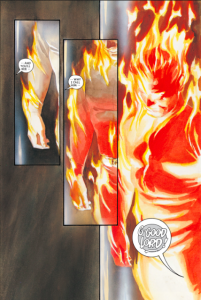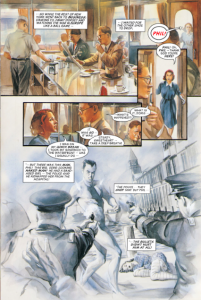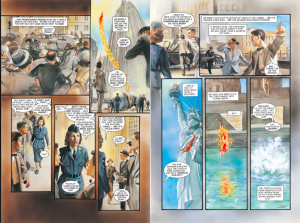I’ve always loved Alex Ross. If ever I’m rich there’s a few things I’ll do: buy cool flats in London, Paris, New York, and Toronto, donate large sums of money to worthwhile causes and churches, attempt to visit fifty-two countries in a year, and buy a tonne of Alex Ross artwork. The privilege of seeing a lot of Ross’ work on display at the Mona Bismark American Center for Art and Culture last week has put his art on my mind as of late. So, when the opportunity to do a retro-review of a comic came up I was thrilled and immediately decided to review Ross’ work with Kurt Busiek on Marvels.
Marvels was published in 1994 — I know, there are more retro-y retro-reviews I could have written, but twenty years is old enough for me. Think about it: Marvels came out while OJ Simpson was showing the world just how slow a Ford Bronco could go, and when both Amazon and WarCraft were born (ensuring that millions of internet savvy gamers and shoppers would never have to leave the house again).
Reading Marvels brought enjoyment to my life in a number of ways: not only did I get to indulge in a little bit of nostalgia while drooling over Ross’ art, I also got to enjoy a really nice story told from a civilian’s perspective. That’s how I would describe Marvels: it’s a nice story. Not an amazing story, not a page-turner, but a solid, enjoyable story to read on a sunny afternoon when you have the time to spare.
 The art is obviously Rossian (I propose that all of you art-critics adopt this term for all future publications referring to Ross’ oeuvre), but it isn’t really Kingdom Come Rossian (although we do get a bit of that at the end of the issue). It’s more Rockwell-esque Rossian (feel free to use that one too, my art-critic friends). The hues are warm and nostalgia seems to be generously lathered onto each page. The postures and facial expression of the characters are very human and help with the characterization more than the dialogue (more on that later). Take, for example, the Human Torch: he says nary a word, but his character is established in his first appearance through his facial expression, which is impressively clear while being veiled by the flames that give him his namesake.
The art is obviously Rossian (I propose that all of you art-critics adopt this term for all future publications referring to Ross’ oeuvre), but it isn’t really Kingdom Come Rossian (although we do get a bit of that at the end of the issue). It’s more Rockwell-esque Rossian (feel free to use that one too, my art-critic friends). The hues are warm and nostalgia seems to be generously lathered onto each page. The postures and facial expression of the characters are very human and help with the characterization more than the dialogue (more on that later). Take, for example, the Human Torch: he says nary a word, but his character is established in his first appearance through his facial expression, which is impressively clear while being veiled by the flames that give him his namesake.
The characterization that the art brings reveals a potential weakness, (or strength, depending on how you look at it), of the writing. I like the plot and the pace of the story overall, and the 1930s style dialogue was amusing, but the characters were not very fleshed out. Even the main character (Phil) isn’t much of a character, not really. He’s a reporter who wants to cover something big but is scared of what’s right in front of him, a pretty realistic internal conflict that should have helped me identify with him, but didn’t. He’s got a “girl” and wants to marry her, but questions his future role as a protective husband (I know, I’ll come back to this) in light of the new superhuman marvels that fill New York’s skyline. He leaves said “girl” to find himself only to return to her by the end of the issue. She, of course, takes him back with open arms. It’s an unfortunately boring love story that doesn’t seem to add much to the narrative at large or any of the characters.
I said earlier t hat the mostly flat characterization of Phil — he has some depth, but not enough to make me care about him or what happens to him — might point to a writing strength. It’s certainly possible that Phil was purposefully written as a flat “everyman.” He may have been written to operate as a mostly nameless lens through which the reader can view the advent of superherodom in Manhattan. If this was the intention, it was certainly realized. Although I did not identify with Phil, I did identify with the nameless, bewildered Marvel universe’s populace of Manhattan during the confusing late-thirties and early-forties.
hat the mostly flat characterization of Phil — he has some depth, but not enough to make me care about him or what happens to him — might point to a writing strength. It’s certainly possible that Phil was purposefully written as a flat “everyman.” He may have been written to operate as a mostly nameless lens through which the reader can view the advent of superherodom in Manhattan. If this was the intention, it was certainly realized. Although I did not identify with Phil, I did identify with the nameless, bewildered Marvel universe’s populace of Manhattan during the confusing late-thirties and early-forties.
If Phil was written to represent the everyman, then his interactions with his fiancée betray the patriarchal overtones of the story. She (Doris) is a completely flat character. She exists as a catalyst to spur Phil to contemplate how he can successfully be a protective husband, and that’s it. Whenever she appears in the story it’s to frighteningly run to Phil to take care of her, make wedding plans with Phil and her mother, be upset with Phil when he leaves her, welcome Phil back when he decides he’d like to marry her after-all, be by Phil’s side as he recovers in hospital, or marry Phil. It’s actually really pathetic.

Thankfully, she’s not the only female character in the story. There’s also a police officer, Betty Dean, who stands her ground when men criticize her and who ends up mediating a temporary peace between the Human Torch and Sub-Mariner. I like Betty Dean a lot. If she appeared in the comic more than twice she would operate as a mirror image of Doris and a critique of 1930s and 40s gender norms.
Unfortunately, she doesn’t, which means that Busiek and Ross really missed an excellent opportunity here.
One last thing I really enjoyed about Marvels — the panel layouts. The way Busiek and Ross employed what would’ve otherwise operated as white gutter space worked perfectly to tell this layered story from multiple perspectives.


